The ASUS ROG STRIX GS-BE18000 tri-band Wi-Fi 7 gaming router was first available at select retailers on May 20, 2025, together with the TUF-BE9400. However, it wasn’t what it was intended to be at launch due to various reasons.
Among those, the support for Automated Frequency Coordination (AFC), the 6GHz band’s most sought-after feature, wasn’t turned on until firmware version 3.0.0.6.102_38782, released in late June. This feature didn’t function fully until firmware version 3.0.0.6.102_38818, which came out in late September.
Here’s the bottom line: If you’re in the market for a gaming router with a ton of 2.5GbE network ports, the GS-BE18000 is worth the current cost of $400, even if you can’t utilize its AFC feature, and when you can, it’s a gratifying Wi-Fi 7 router. Get one today!
Dong’s note: I first published this review on July 17, 2025, and updated it on September 30, 2025, to reflect the improvement of the AFC feature, which is only available in select regions.
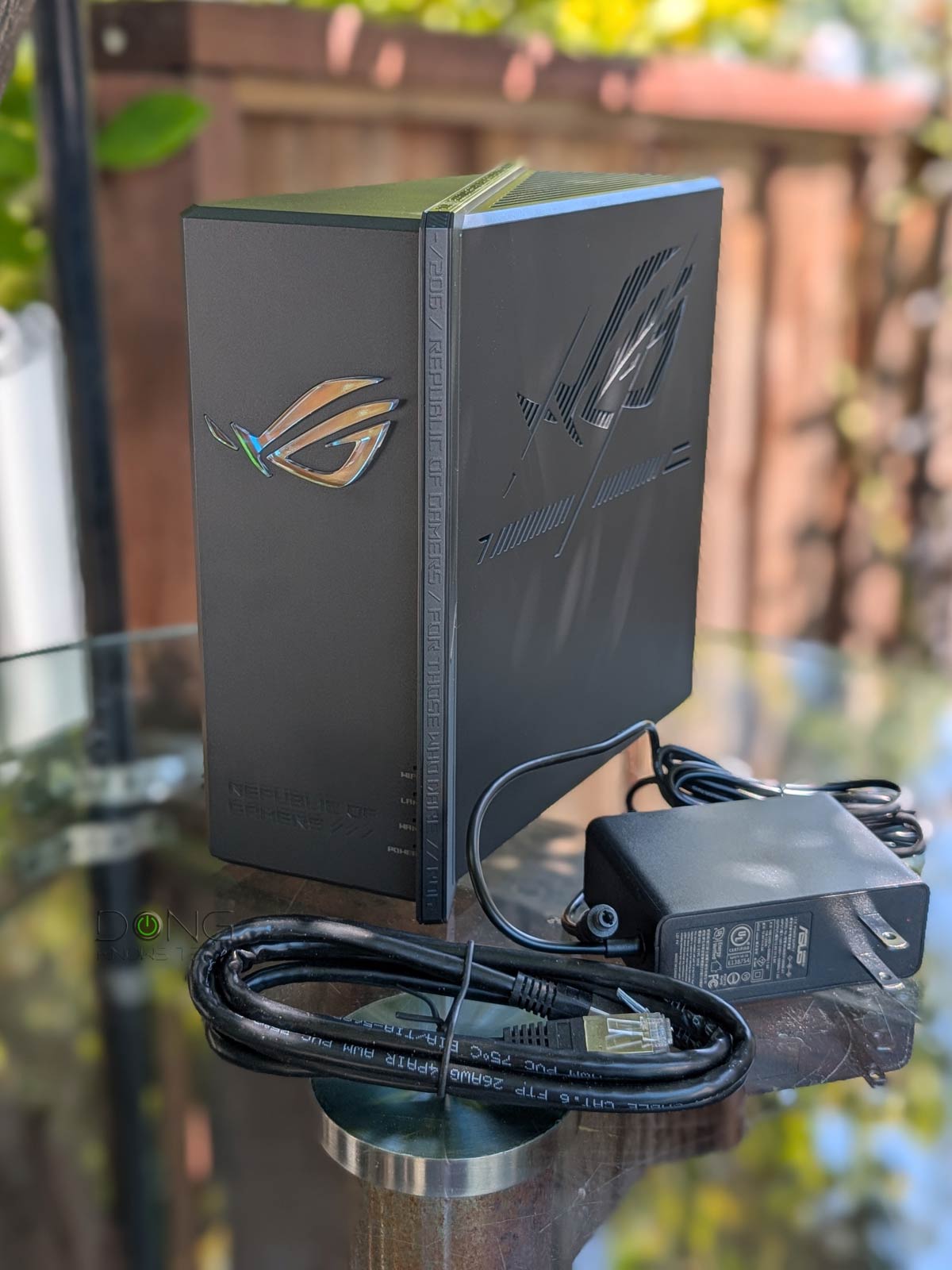
ASUS ROG STRIX GS-BE18000: A compact top-tier gaming router with entry-level Multi-Gig ports
Out of the box, the GS-BE18000 looks more like a mini computer than a Wi-Fi router. It’s a compact rectangular box designed to stand vertically on a surface—it’s not mount-ready.
On the front, it features a ROG logo with ASUS’s ROG Aura RGB lighting effects, which can be programmed via the web user interface or the ASUS mobile app.
On the back, there are two vertical rows of eight 2.5 GbE ports, one of which is designated as the default WAN port, with the remaining ports being LANs. Among the LANs, ports 5 and 6 are dedicated gaming ports—connect a device to either, and it’ll automatically be prioritized for games.
On the inside, ASUS shares that the GS-BE18000 features two advanced Wi-Fi chipsets: one for the 2.4GHz and 5GHz bands, and the other for the 6GHz band exclusively. These chips feature EMI shielding to work with high-power front-end modules (FEMs) and include eight internal antennas, providing optimal performance and support for the AFC feature mentioned above.


The router’s high-end Wi-Fi specs make its lack of 10Gbps ports a disappointment. No matter how fast your Wi-Fi is, the router’s bandwidth is limited at its ports, which are all 2.5Gbps. The table below shows its detailed hardware specs.
ASUS GS-BE18000: Hardware specifications
| ROG STRIX GS-BE18000 Wi-Fi 7 Gaming Router | |
|---|---|
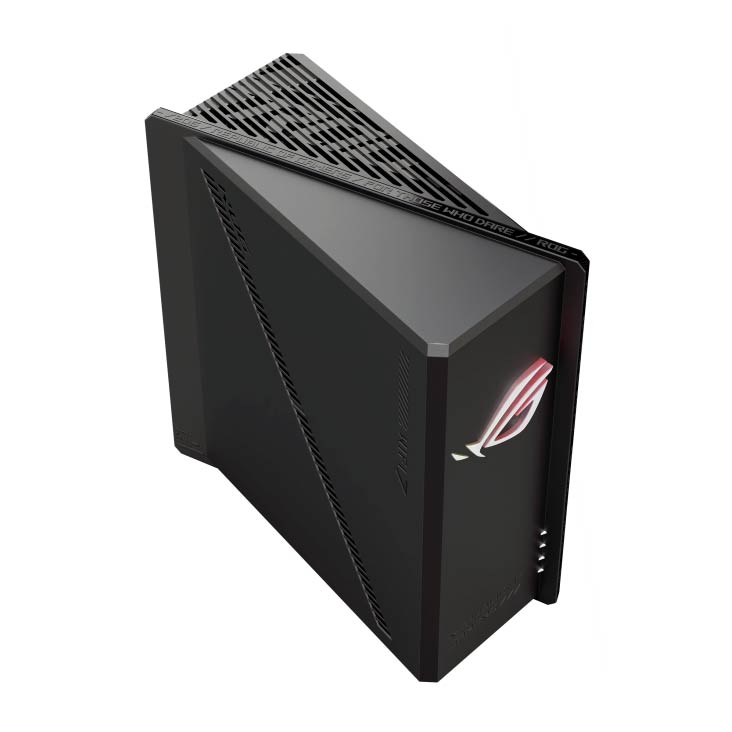 | |
| Model | GS-BE18000 |
| Antennas | 8 x Internal |
| Wi-Fi Bandwidth | Tri-band BE18000 |
| Modulation Scheme (QAM) | 4096-QAM (all bands) |
| 2.4GHz Band (channel width) | 2×2 BE: Up to 688Mbps |
| 5GHz Band (channel width) | 4×4 BE: Up to 5762Mbps (20/40/80/160MHz) |
| 6GHz Band (channel width) | 4×4 BE: up to 11,525Mbps (20/40/80/160/320MHz) (all channels) |
| Multi-Link Operation (MLO) | Yes |
| Automated Frequency Coordination (AFC) | Yes (via latest firmware) |
| Network Standards | IEEE 802.11a, IEEE 802.11b, IEEE 802.11g, IEEE 802.11n, IEEE 802.11ac, IEEE 802.11ax, IEEE 802.11be, IPv4, IPv6 |
| Network Features | Web User Interface ASUS Mobile App ASUS Core Features |
| Gaming Features | ASUS Gaming Features |
| Mesh-Ready | Yes (AiMesh) |
| Processing Power | 2GHz CPU, 256MB Flash, 2GB DDR4 RAM |
| Multi-Gig Port | 1x 2.5GBASE-T WAN, 7x 2.5GBASE-T LAN |
| Gigabit Port | None |
| USB Port | 1 x USB 3.0 |
| Hardware Buttons | WPS Button, Reset Button, Power Button |
| Dimensions | 8.86 x 3.54 x 8.86 in (225 x 90 x 225 mm) |
| Weight | 2.04 lbs (927.5 g) |
| Release Date | TBD |
| DC Power Adapter | 100~240 V |
| Firmware Version (for review) | 3.0.0.6.102_38782 and 3.0.0.6.102_38818 |
| Power Consumption (per 24 hours) | ≈ 340Wh |
| US Launch Price | $449.99 |


Asus’s first router with working AFC
As noted in the table above, the GS-BE18000 supports AFC. It’s the first among ASUS routers, and among all home routers on the market, in fact, to do so, although it wasn’t the first intended to be. Indeed, initially, ASUS wanted the ZenWiFi BQ16 Pro to be the first to feature this capability. Both are AFC-ready in terms of hardware, and neither had the feature at launch.
Tip
Automated Frequency Coordination (AFC) extends the Wi-Fi range of the 6GHz band to be comparable to that of the 5GHz band via special rules.
The feature is similar to checking with the local authorities for permission to close off sections of city streets for a drag race block party.
When approved, the usual traffic and parking laws no longer apply to the area, and the organizers can determine how the traffic can flow, among other things.
In late June 2025, ASUS released a firmware update (version 3.0.0.6.102_38782) for the GS-BE18000, which enabled users to activate the AFC feature. The company informed me that this feature would be available only in North America, and its success with the GS-BE18000 would determine whether and when its other Wi-Fi 7 broadcasters, including the ZenWiFi BQ16 Pro, would also get AFC.
If you’re unfamiliar with the feature, this post on the subject has all the details, but the gist is:
- AFC is available only on the 6GHz frequency band, which itself is regulated differently around the world. Some regions may not have it, while others have only a narrow portion, making it less significant than its potential.
- AFC requires authorization from local regulators. The hardware, therefore, among other things, must know its precise real-world location, which can raise privacy concerns, and the logistics can be complicated.
The point is that even in regions where the AFC is supported, its availability may change over time depending on local regulations and the broadcasters’ availability to determine its precise GPS location. And that proved to be somewhat of a sticking point in the case of the GS-BE18000 in my experience.


It’s easy to turn on the AFC support on the ASUS GS-BE18000. You can do that either via its web user interface or the ASUS mobile app. Simply, go to the wireless (or Wi-Fi) section and select to enable the feature.
However, having this feature on doesn’t automatically mean it’s in effect. The router continues to use its default broadcasting mode, called “Low Power Indoor” mode, until it receives authorization to switch to the higher “Standard Power” mode, which boosts the 6GHz band’s range.
And getting the local authorization is where things became complicated.
For one, the router itself has no mechanism to determine its precise geographical location, as the information it can obtain from the WAN IP address is not accurate enough. Instead, it draws the location from connected clients, such as smartphones. This approach is generally the case with all home-grade routers that support AFC.
Specifically, ASUS told me that I should use the ASUS router app on my phone, which is a Pixel 9 Pro XL, and:
- Enable the AFC feature, or make changes to it, such as changing the 6GHz band’s channel width, through the app while your phone is connected to the router’s Wi-Fi.
- Doing that while the phone is being used in the open to get the best GPS signal.
While it may sound simple enough, the details can become complicated. For one, when you turn the AFC feature on or off, it may cause the 6GHz band, or even the router itself, to restart.
That was almost always the case with the 3.0.0.6.102_38782 firmware version, making it somewhat challenging to determine if AFC was in effect, and my GS-BE18000 unit’s AFC was indeed almost never in effect when I checked, because it didn’t find my phone’s GPS geolocation uncertainty within the accepted level to switch to the “Standard Power” mode.
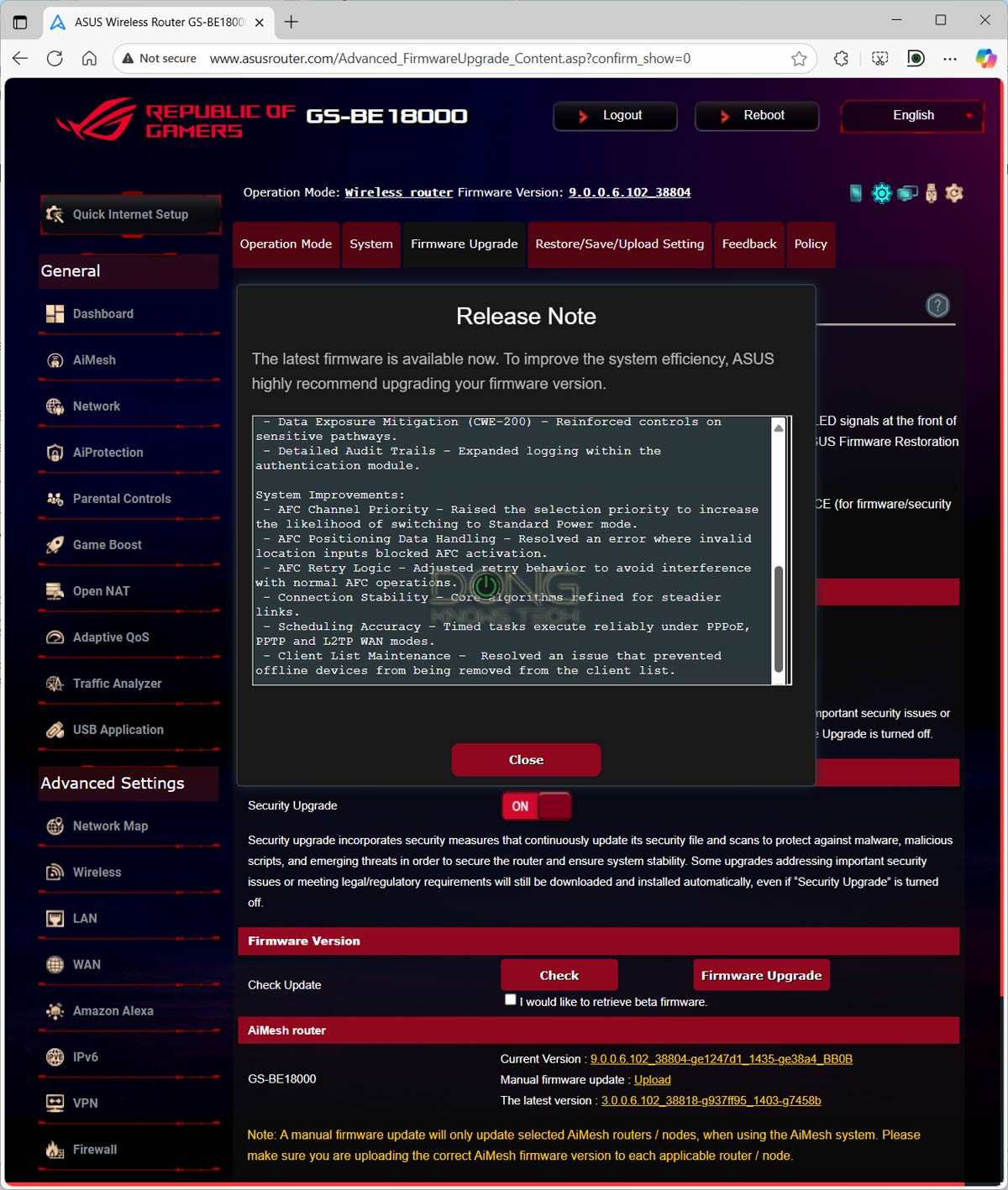
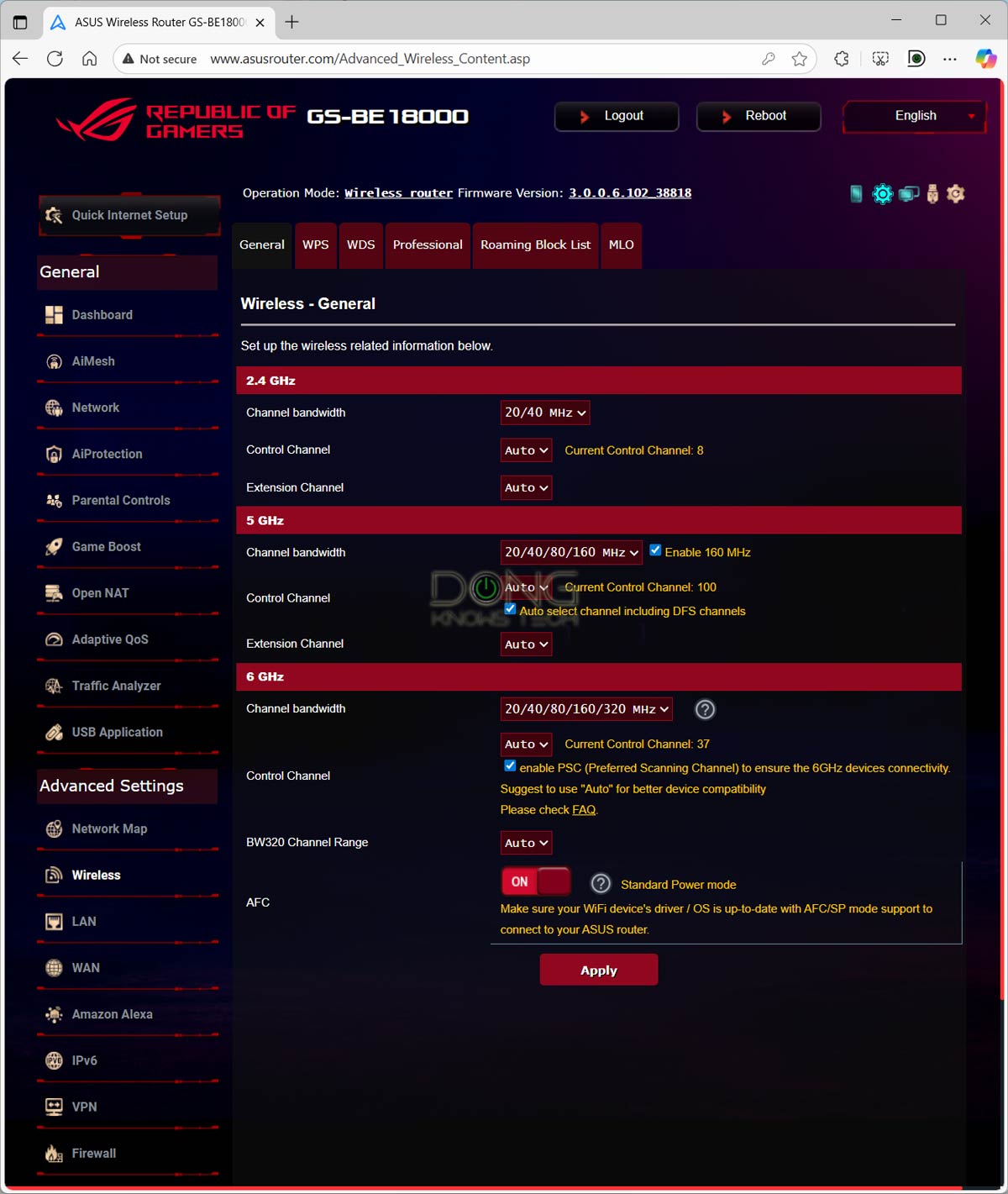
Things were significantly improved with firmware version 3.0.0.6.102_38818—a hardware hard reset is recommended after the upgrade. Now, as long as I had the phone connected to the GS-BE18000’s Wi-Fi network and out in the open with clear GPS signals, the router automatically switched to Standard Power mode and worked consistently with AFC in effect, which significantly improved the range of the 6GHz band.
When my phone lost its GPS reception, such as when I moved it indoors, the router’s Standard Power mode remained active for an extended period, although it would eventually switch back to Low Power Indoor mode.
How long is this “extended period” you wonder? I didn’t measure it precisely, but generally, an AFC-enabled access point must report its GPS coordinates at least once every 24 hours to remain compliant, and the GS-BE18000 is likely no exception. In my case, my moving in and out with the phone in hand proved to be enough for the router to maintain its AFC.
That said, to reliably use AFC on the GS-BE18000, these two requirements must be met:
- The router is used in a region where AFC is allowed, namely North America.
- One of its connected clients must provide a precise GPS location. In most cases, that’d be a Wi-Fi 7-ready mobile phone with the ASUS router app running (in the background) and:
- The ASUS mobile app must have permission to access the phone’s background real-time location at all times.
- The phone must have clear GPS signals; i.e., it should be placed outdoors under a clear sky to enable the AFC, and periodically receive a clear GPS signal while connected to the router’s Wi-Fi network to maintain the AFC’s effect.
When any of the conditions above are not met, AFC is either unavailable or not in effect.
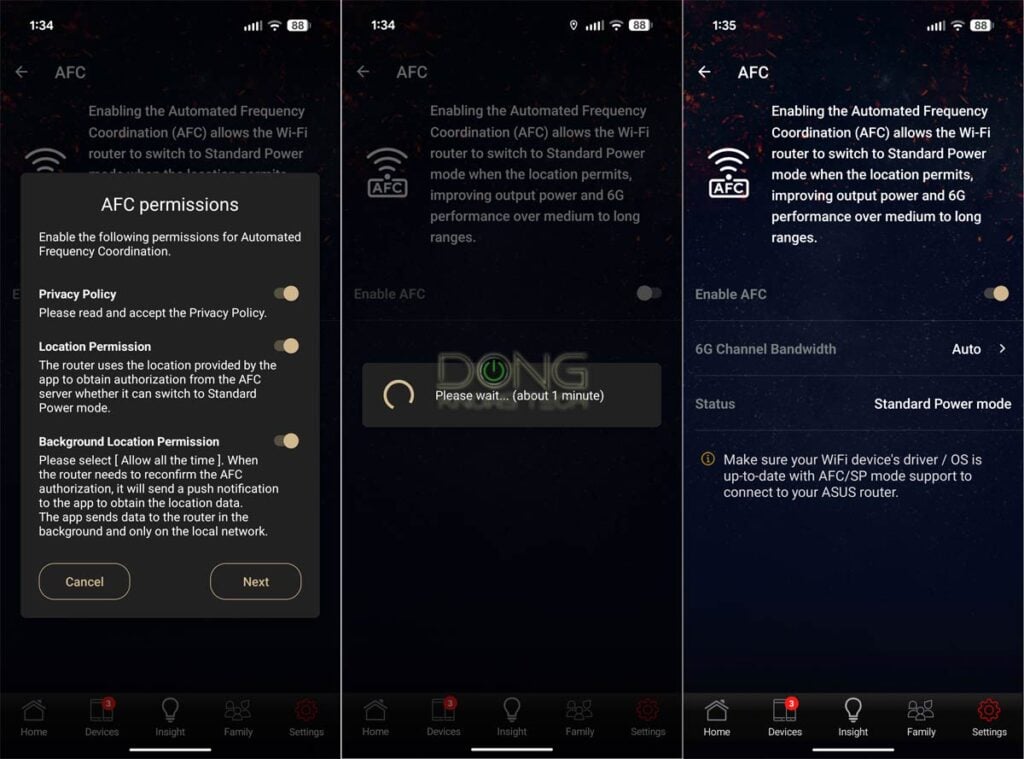
That said, using AFC means you’ll have to surrender your location privacy to the vendor. However, that’s the general case of the feature itself and not specific to ASUS or the GS-BE18000 in particular. The only difference is that other hardware models, such as outdoor access points, may have a more robust method for obtaining a precise location without placing that burden on a connected client.
GS-BE18000: A typical ASUS gaming router
Wi-Fi 7 and AFC aside, as part of the ROG STRIX family designed for budget-minded users, the GS-BE18000 features the standard set of ASUS’s gaming enhancements, including a Game port and ROG Aura RGB lighting effects.
Unlike higher-tier gaming hardware, it doesn’t support a gaming private network or Game Radar. Still, it has everything most gamers need. The table below compares it to other ASUS gaming routers.
| Multi-Gig Port | Gaming Private Network | ROG First, Game Radar | Gaming Port | GeForce Now | Aura Lights | |
|---|---|---|---|---|---|---|
| GT-BE19000AI | 2x10GbE 4×2.5GbE | GTNET | Yes | No | Yes | |
| TUF-BE6500 | 4×2.5GbE | WTFast | No | Yes | No | |
| GS-BE18000 | 8×2.5GbE | No | Yes | No | Yes | |
| RT-BE86U | 1x10GbE 4×2.5GbE | No | Yes | No | ||
| RT-BE88U | 1x10GbE 1xSFP+ 4×2.5GbE | No | Yes | No | ||
| RT-BE96U | 2x10GbE | No | ||||
| GT-BE98 Pro | 2x10GbE 4×2.5GbE | WTFast | Yes | No | Yes | |
| RT-AX88U Pro | 2×2.5GbE | WTFast | No | |||
| GT6 (mesh router) | 1×2.5GbE | No | Yes | No | Yes | |
| GT-AXE16000 | 1×2.5GbE 2x10GbE | WTFast | Yes | No | Yes | |
| GT-AX11000 Pro | 1×2.5GbE 1x10GbE | WTFast | Yes | |||
| GT-AXE11000 | 1×2.5GbE | Outfox | Yes | No | Yes | |
| GT-AX11000 | 1×2.5GbE | WTFast | Yes | No | Yes | |
| GT-AX6000 | 2×2.5GbE | No | Yes | No | Yes | |
| GS-AX5400 | None | No | Yes | No | Yes | |
| GS-AX3000 | None | No | Yes | No | Yes | |
| RT-AX88U | None | WTFast | No | |||
| RT-AX89X | 1x10GbE 1xSFP+ | No | ||||
| RT-AX86U | 1×2.5GbE | No | Yes | No | ||
| RT-AX86S | None | No | Yes | No | ||
| RT-AX82U | None | No | Yes | No | Yes | |
| RT-AX92U (canned mesh) | None | WTFast | No | |||
| TUF-AX5400 | None | No | Yes | No | Yes | |
All of these routers have the standard set of ASUS’s gaming features, including Mobile Game Mode, Open NAT, Gear Accelerator, and VPN Fusion.
Aside from that, running ASUSWRT 5.0, the router features the core capabilities of all ASUS routers, with slight variations in various areas. Specifically, you can expect the following:
- Flexible WAN/LAN configurations:
- The GS-BE18000 features dual-WAN. You can use its default WAN and turn one of its LAN ports or the USB port into a second WAN port.
- Use the USB port as a third WAN source to host a tethered smartphone or cellular modem.
- Unlike most other ASUS routers, the GS-BE18000 does not feature Link Aggregation. That’s likely because there’s little practical use in bonding two 2.5Gbps ports into a 5Gbps link.
- Universal backup restoration: The GS-BE18000 can load the backup file of almost any other ASUS router, making upgrading from one router to another quick and easy. I tried using the backup files of the RT-BE86U and a few others, and they loaded without any issues. (Note, though, that not all settings can be ported, depending on the models, and generally, it’s best to set up a router from scratch.)
- Robust web user interface with optional ASUS Router mobile app. You can set up the router the way you do any standard router via its default IP address, which is 192.168.50.1.
- AiMesh support. The GS-BE18000 works best with wired backhauling, but thanks to MLO, it can be reasonably used with any other tri-band Wi-Fi 7 AiMesh broadcaster in a wireless setup, as long as multiple units are used (and not a mixed hardware setup).
- Built-in Parental Controls and online protection (AiProtection) plus other traffic-related features.
- USB-based features (cellular tethering, network storage, media streaming server, etc.)
- The new router supports advanced VPN, including WireGuard and Instant Guard.
- Tons of helpful network/Wi-Fi settings, tools, and other features, including QoS and web-based remote management via Dynamic DNS.
So, if you had an ASUS router before moving to the GS-BE18000, it would be a walk in the park. Most of what it can do is self-explanatory.


ASUS ROG STRIX GS-BE18000: Solid performance
I tested the GS-BE18000 for a couple of months, during which a significant amount of time was spent on the AFC feature, which changed from barely available to fully functional with the latest firmware. Overall, at the current state, the GS-BE18000 performed well with Wi-Fi rates being limited only by its network ports, as shown in the charts below.
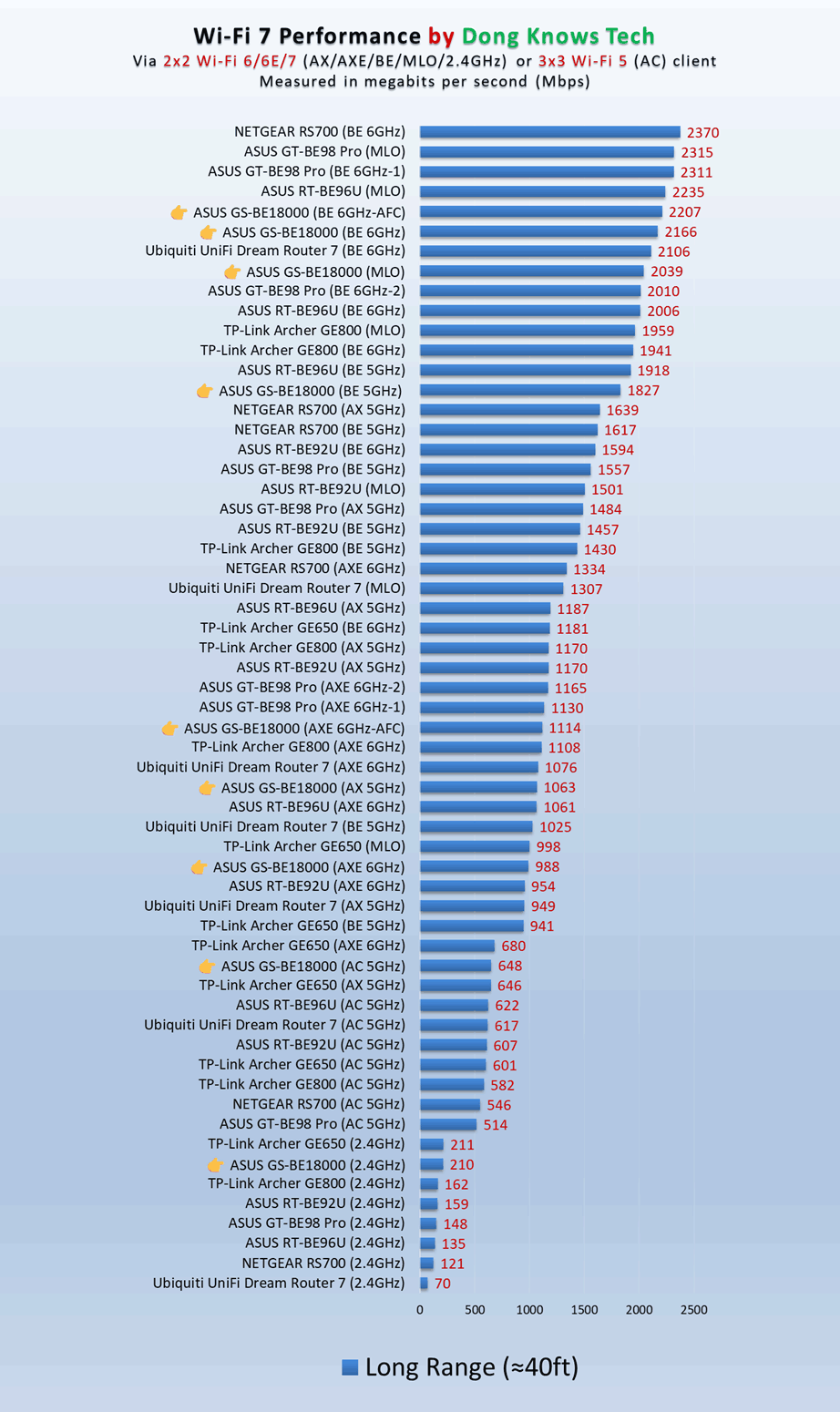
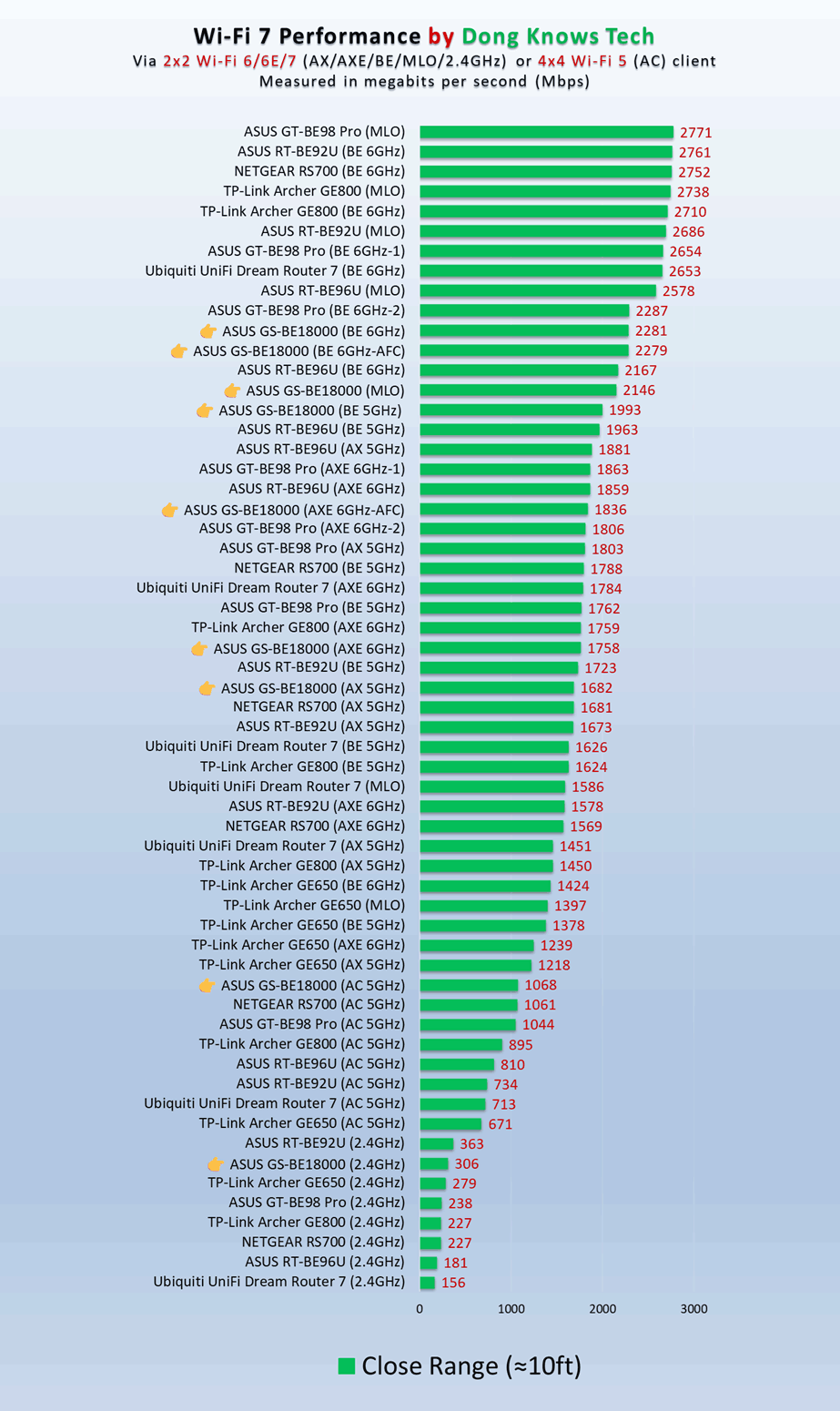
The router’s range proved to be similar to that of a high-end Wi-Fi 7 router. It’s challenging to measure coverage precisely, but if you live in a home of around 2,500 ft² (232 m²) with thin walls, placing this router near the center should likely provide blanket coverage. Still, your mileage will vary.
It’s worth noting that with the AFC in effect, the 6GHz band’s range proved to be similar to that of the 5GHz band, which was quite excellent. Another thing to note is that AFC didn’t consistently improve the real-world data rates in my case, just the range. While the numbers on the charts may show some fluctuation, for both Wi-Fi 7 and Wi-Fi 6E clients, with and without AFC, they simply reflected how Wi-Fi generally works, and not necessarily the effect of AFC.
Wi-Fi aside, I also tested the GS-BE18000’s NAS feature by connecting a portable SSD to its USB 3.0 port, and the performance was relatively modest.
Via a 2.5Gbps wired connection, the data transfer rates sustained between 50MB/s and 75MB/s for write and read operations, respectively. That’s fast enough for casual data sharing, but not much else.


The router’s 2.5Gbps ports themselves performed as expected, averaging middle of the pack when compared with other routers of the same port grade.
The GS-BE18000 seemed to have no internal fan, and it was silent during operation. It also remained cool to the touch, which is always a good thing. With the latest firmware, it also passed my three-day stress test without disconnecting once, demonstrating its reliability as a Wi-Fi machine. It’s essential to note that I performed the street test without any of its gaming or traffic-related features enabled.
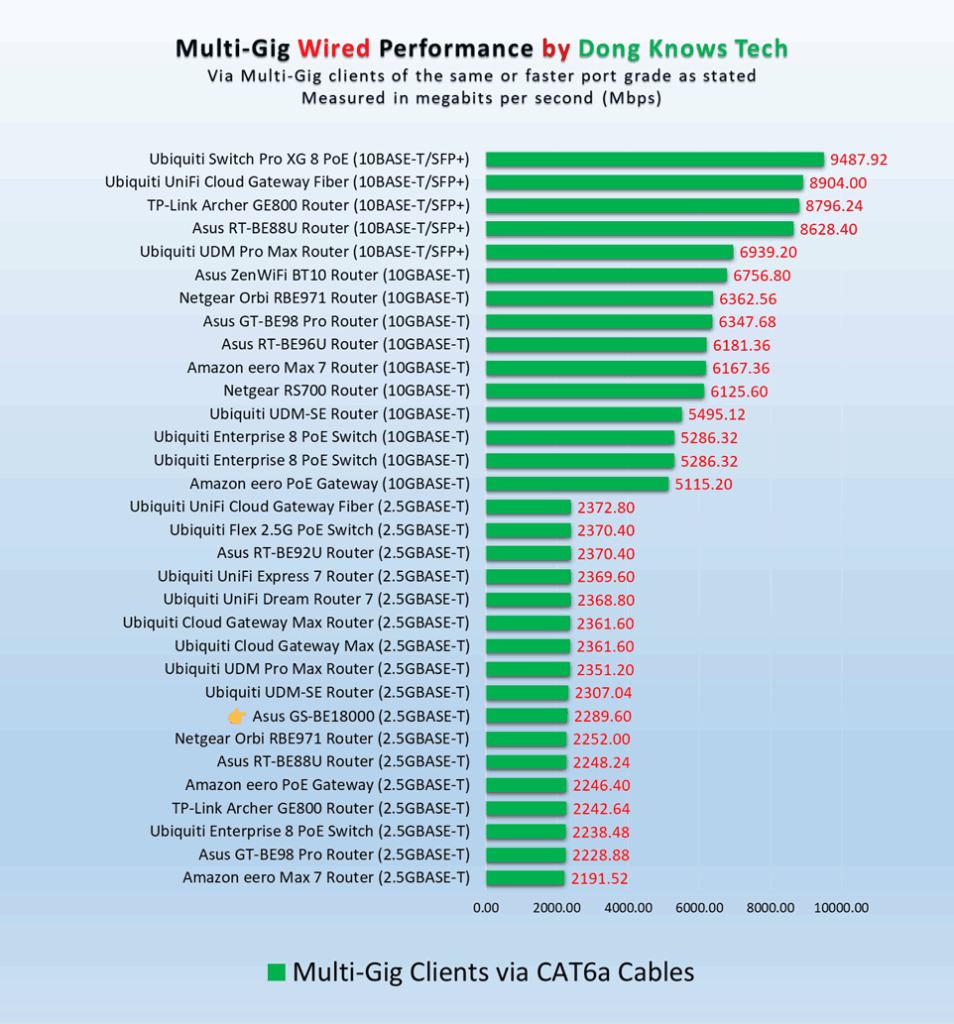
Overall, the GS-BE18000 is an excellent router from a performance perspective, and its AFC feature, when available, proves to be a valuable bonus, even a pleasant surprise.
ASUS ROG Strix GS-BE18000's Rating
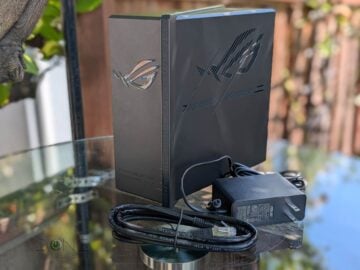
Pros
Excellent overall performance, eight 2.5Gbps ports, AiMesh-ready, official AFC support with extended 6GHz range
Lots of free, in-depth, and useful networking features and settings (VPN, AiProtection, Parental Control, Bandwidth monitoring, etc.)
No vendor required login account; fanless; runs cool and quiet
Cons
No 10Gbps port
AFC needs help from a supported client in getting precise GPS coordinates
NAS performance (when hosting a portable SSD) could be better
Conclusion
Among other things, the ASUS ROG STRIX GS-BE18000 offers a reason why the adoption of Wi-Fi 7’s AFC has been slow. It’s a complicated feature. However, it also proved that with time, things will get better.
That said, if you live in an area where the 6GHz band is available, go ahead and get this router today! If you need no more than 2.5 Gbps of bandwidth, such as having a Gigabit or higher broadband connection, you might be in for a pleasant surprise.
Hopefully, and even likely, other ASUS routers, such as the ZenWiFi BQ16 Pro, will also receive AFC soon. But don’t quote me on it.


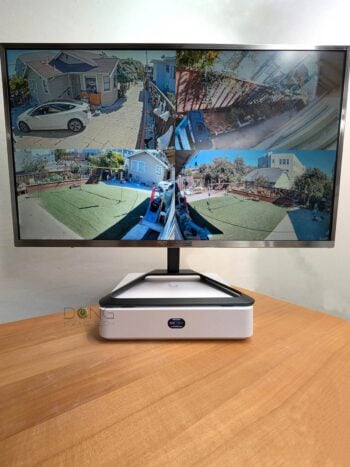
I would like to purchase two of these to use in a wireless mesh setup. Would there be any reason to get a pre-packaged mesh setup like the BT6/8/10 over running two GS-BE18000? Thanks for all of the work you put into these reviews.
The only benefit of getting the packs is that the units are pre-synced, Matt. Go ahead!
It looks like your Amazon link points to the BE12000 version? Or that’s the closest thing Amazon can find?
I am wondering if you saw any upload performance issues that I saw on a post in an SNB forum? I can share the link to that question if OK for you.
Looks like it’s not yet available on Amazon, Brent, and my system automatically picked the closest thing. That happens sometimes.
There’s no upload issue in my exprience and I useed that thing for months. I have a 10Gbps Internet and speed testing is tricky.
I see in your tests that the dual-band Asus routers(BE86U) perform better than their tri-band counterparts (BE1900, BE96U) in the 5ghz region at least in the long range tests. Do you have any idea why? Is it power management and thermals maybe because they luck one additional radio?
It can be many things including the fact they were tested using different firmware versions (as shown on the specs tables), Dimitris. In any case, the differences are within normal margins if fluctuation, or luck, as you noted.
I have the gt ax6000 right now how much better is this router then what I got now would it be worth getting to upgrade?
Here’s the review of the GT-AX6000, Dallas. Give it a read and you’ll have your own answers. This post on when to replace a router will help, too.
I bought this router from Best Buy a while back, and it was terrible… until the latest firmware update… In hindsight, I should have waited for your review. Hopefully, Asus will get its AFC thing together. Thanks for all that you do, Dong!
You got it, Aaron. Asus’s stuff is known to be buggy at launch. This router wasn’t even meant to be “ready” when announced. I’d recommend backing it up, resetting, and restoring it. It’ll work much better! Cheers!